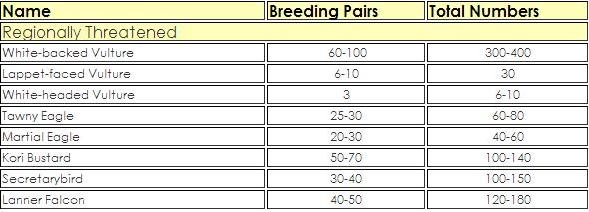IBA Kalahari Gemsbok National Park
SA Number: SA 027
Status: Global IBA (A3)
Site Description
Situated in the sliver of land between Botswana and Namibia, 320 km north of Upington, the Kalahari-Gemsbok National Park (K.G.N.P.) forms a relatively small, but vital part of the large semi-arid southern Kalahari ecosystem. The Park adjoins Botswana's Gemsbok National Park and the Mabuasehube Game Reserve (IBA B012), forming a huge area (3.6 million hectares) under official conservation. This in turn joins wildlife management areas, creating a quasi-protected district c. 8 million ha in size. The entire region is covered by infertile red Kalahari sand overlying limestone and calcareous sandstone layers that are exposed in dry riverbeds and endorheic pans. Rainfall, which is erratic, both temporally and spatially, ranges from 150 mm p.a. in the southwest to 300 mm p.a. in the northeast. Average annual minimum and maximum temperatures are 4°C and 32°C respectively.
The vegetation is largely Kalahari thornveld and it occurs as an open tree, dune or shrub savanna. Tree and dune savanna is found adjacent to the Nossob and Auob rivers.
Occasionally, narrow dune belts separate the extensive flat plains that occur between the two rivers. The Nossob and Auob rivers are important features of the Park, holding the greatest densities of tall trees.
The Nossob, which forms the international border with Botswana, stretches in an arc from the Park's southern entrance at Twee Rivieren to Union's End where South Africa, Botswana and Namibia meet. The riverbed varies in width from a narrow channel 100–500 m across to a wide sandy floodplain up to a kilometre or more in breadth. The Auob River, which forms the Park's southwest boundary, cuts through a calcrete layer for much of its length, resulting in a channel which in places is 40 m deep and 800 m wide.
The Park's abundant calcareous and salt pans are mineralogically richer than the surrounding sandveld and consequently support different vegetation. The pans are often used as mineral licks by game when nutrients are scarce in the surrounding environment. The desert nature of the system also yields a large number of ephemeral forbs; when it rains dormant seeds germinate and their life-cycles are completed rapidly and seeds are set. The Tsama Melon
Citrullus lanatus and Gemsbok Cucumber
Acanthosicyos naundinianus are important sources of food and water in the Kalahari. Within this large conservation area, the most important habitats for ungulate and predator populations are the dry Nossob and Auob riverbeds, along which they are heavily concentrated. The saline pans with their associated dominant dwarf shrub cover are, together with the rivers, focal areas for large herbivores as they are a source of minerals to animals at all times and a source of water in the rainy season.
Birds
The Park supports over 214 bird species. Only 75 of these are resident; the large majority of the remainder are characteristically nomadic, moving into the area temporarily when conditions are suitable. The residents display a wide variety of behavioural adaptations to cope with unfavourable dry conditions. Shifting nest position, altering activity rhythms and modifying egg-hatching behaviour are all used to cope with extreme levels of heat stress. This Park supports important populations of several raptor species, especially vultures. White-backed Vulture and Lappet-faced Vulture occur in good numbers, whereas White-headed Vulture are scarce and Cape Vulture are only occasionally seen foraging in the Park.
The vultures show a preference for the Nossob and Auob riverbeds as both have large trees suitable for nesting and roosting. Other threatened breeding raptors include the Bateleur, Martial Eagle and Tawny Eagle. The wide plains of the reserve are home to Kori Bustard, Ludwig's Bustard and Karoo Korhaan. Waterholes attract Burchell's Sandgrouse and Namaqua Sandgrouse, which occasionally gather in very large numbers.
The Kalahari thornveld holds typical Kalahari basin birds, such as Kalahari Scrub-Robin, Crimson-breasted Shrike, Burchell's Starling, Shaft-tailed Whydah, Monotonous Lark, Southern Pied Babbler, Barred Wren-warbler, Marico Flycatcher and the Sociable Weaver, which constructs huge communal nests in the larger trees.
Wherever seeding grasses sprout, Red-headed Finch, Black-faced Waxbill and Violet-eared Waxbill are found. Stark's Lark and Black-eared Sparrow-lark are nomadic species that sporadically occur in the Park when conditions are favourable.
Key Species
Threatened Species
 Range and Biome Restricted Species
Range and Biome Restricted Species
 Other threatened/endemic wildlife
Other threatened/endemic wildlife
The Gariep Blind Legless Skink
Typhlosaurus gariepensis is endemic to the vegetated sand ridges in the dune fields of the southern Kalahari, and is almost restricted to the Park. The southern African endemic Dwarf Beaked Snake
Dipsina multimaculata, Kalahari Spade-snouted Worm Lizard
Monopeltis leonhardi, Spotted Desert Lizard
Meroles suborbitalis, Kalahari Ground Gecko
Colopus wahlbergii and Woosnam’s Desert Rat
Zelotomys woosnami are all common within the Park; Boyle’s Beaked Blind Snake
Rhinotyphlops boylei may just enter the Park, near Union’s End.
The K.G.N.P. is the second largest National Park in South Africa and one of a few remaining wilderness areas in the country supporting natural populations of large mammals. The Park supports important populations of Lion, Leopard, Cheetah, Spotted Hyaena, Brown Hyaena, African Wild Cat, Aardwolf, Aardvark, Honey Badger and Pangolin.
Download PDF Site Description


